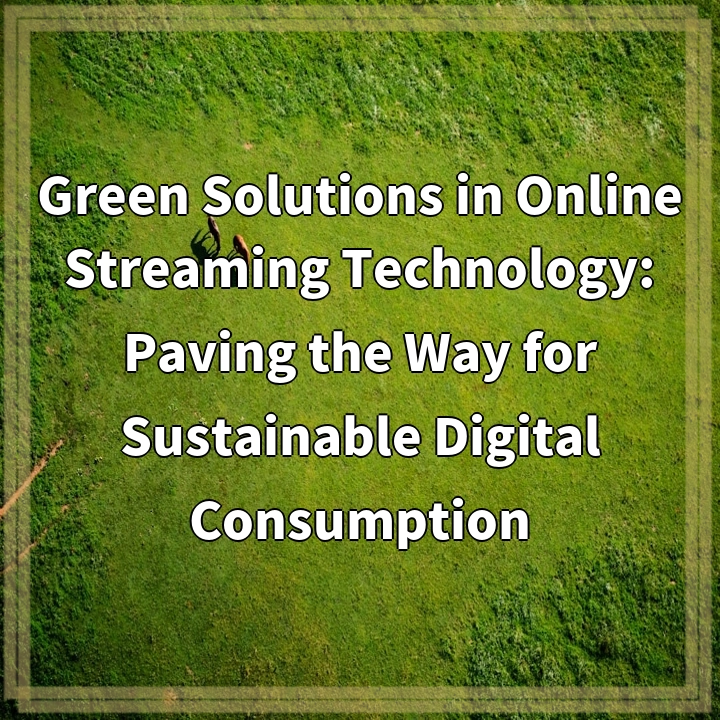
What it is:
Online streaming technology refers to the delivery of audio and video content via the internet, allowing users to access media on-demand without the need for downloads. This technology has transformed how we consume entertainment, education, and information, making it a convenient and engaging option for millions of people worldwide. However, the rise of streaming platforms like Netflix, Hulu, and YouTube has also raised concerns about their environmental impact, particularly regarding energy consumption and carbon emissions associated with data centers and streaming devices.
Real-world problems
One of the primary real-world problems associated with online streaming technology is its substantial energy consumption. Data centers, which host the servers necessary for streaming services, require immense amounts of electricity to operate and maintain optimal temperatures. As demand for streaming increases, so does the energy required to power these facilities, leading to greater carbon footprints if the energy sources used are not renewable.
Data Transmission Footprint
Additionally, the data transmission that occurs when content is streamed contributes to environmental issues. The process of transmitting large files over the internet consumes significant energy and relies heavily on the infrastructure of internet service providers (ISPs). If this infrastructure is not powered by renewable energy sources, the environmental impact can be severe, exacerbating climate change and increasing greenhouse gas emissions.
Electronic Waste
Another pressing issue is the electronic waste generated by streaming devices and related technology. As streaming becomes the preferred method of media consumption, older devices are often discarded or replaced with new ones to meet updated standards for quality and performance. This contributes to the growing problem of e-waste, which can release harmful materials into the environment if not disposed of properly.
Consumer Awareness and Responsibility
Lastly, consumer awareness plays a crucial role in mitigating the environmental impact of streaming technology. Many users are unaware of the energy consumption associated with streaming or how their choices influence the industry’s carbon footprint. Encouraging sustainable practices among consumers, such as adjusting streaming quality or opting for eco-friendly devices, can significantly contribute to reducing the environmental impact.

Solutions for Sustainable Online Streaming
Addressing the environmental concerns associated with online streaming technology requires a multifaceted approach that includes innovations in energy efficiency, consumer education, and the adoption of renewable resources. Here are some key solutions that can pave the way for sustainable digital consumption.
1. Energy-Efficient Data Centers
Investing in energy-efficient data centers is crucial. Companies can implement advanced cooling systems, optimize server configurations, and utilize energy-efficient hardware to reduce overall energy consumption. Furthermore, transitioning to renewable energy sources, such as solar or wind power, can significantly lower the carbon footprint of these facilities.
2. Eco-friendly Networking Infrastructure
Improving the energy efficiency of networking infrastructure is essential for reducing the data transmission footprint. Internet service providers can enhance their networks to be more energy-efficient and invest in technologies that minimize energy use during data transfer. Utilizing green technologies and solutions can help in achieving these goals.
3. Promotion of Sustainable Devices
Encouraging the use of eco-friendly streaming devices can help mitigate electronic waste. Manufacturers should focus on designing products that are energy-efficient, durable, and easily recyclable. Implementing take-back programs can also support responsible disposal and recycling of old electronics, reducing the impact of e-waste.
4. User Awareness and Behavioral Changes
Raising consumer awareness about the environmental impact of streaming can drive behavioral changes. Educating users about the benefits of lowering streaming quality, turning off devices when not in use, and choosing energy-efficient equipment can significantly reduce overall energy consumption.
5. Collaborative Industry Efforts
Collaboration among streaming companies, technology manufacturers, and environmental organizations is vital for developing industry-wide standards for sustainability. By working together to share best practices and promote green technologies, stakeholders can create a more environmentally responsible streaming ecosystem.















